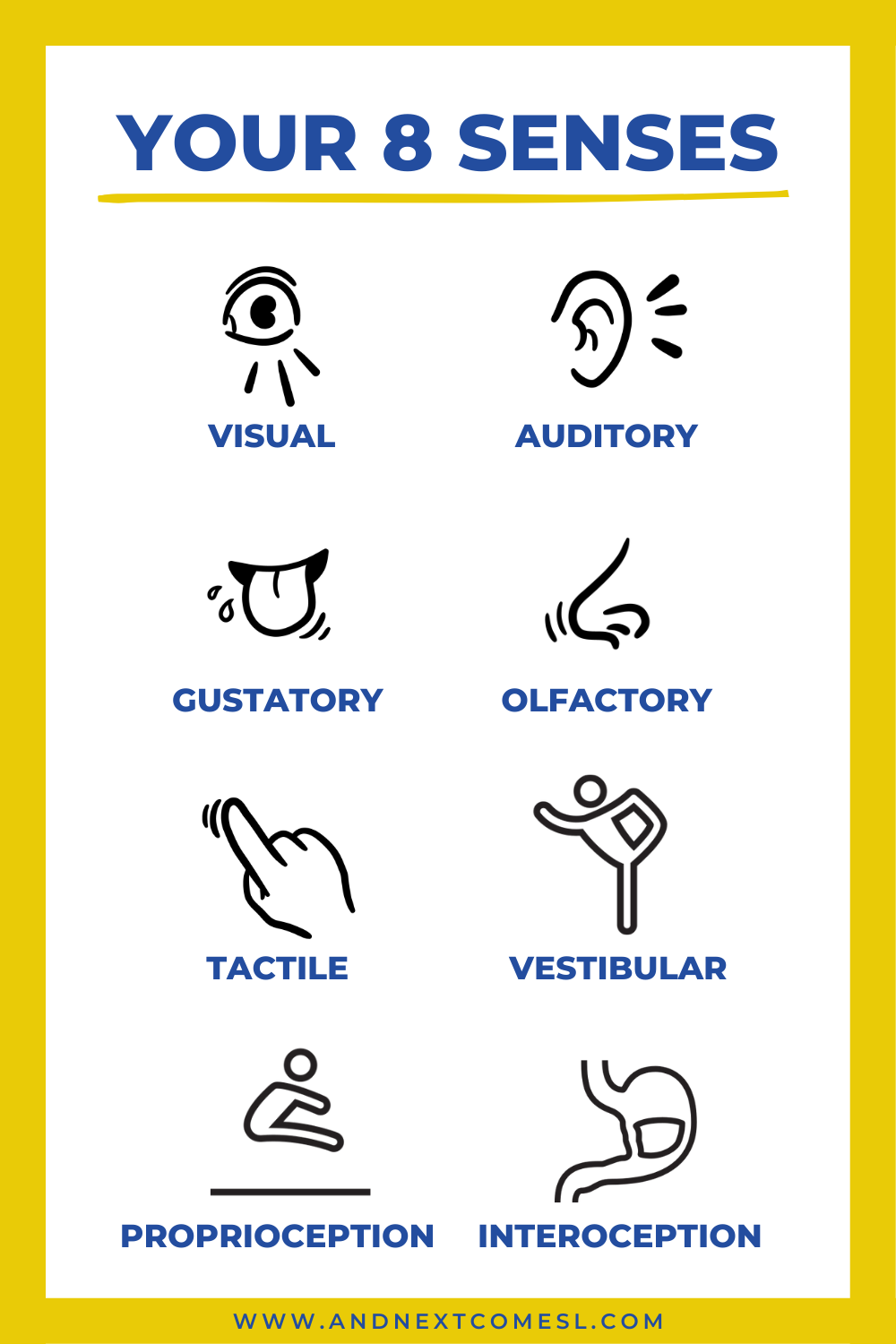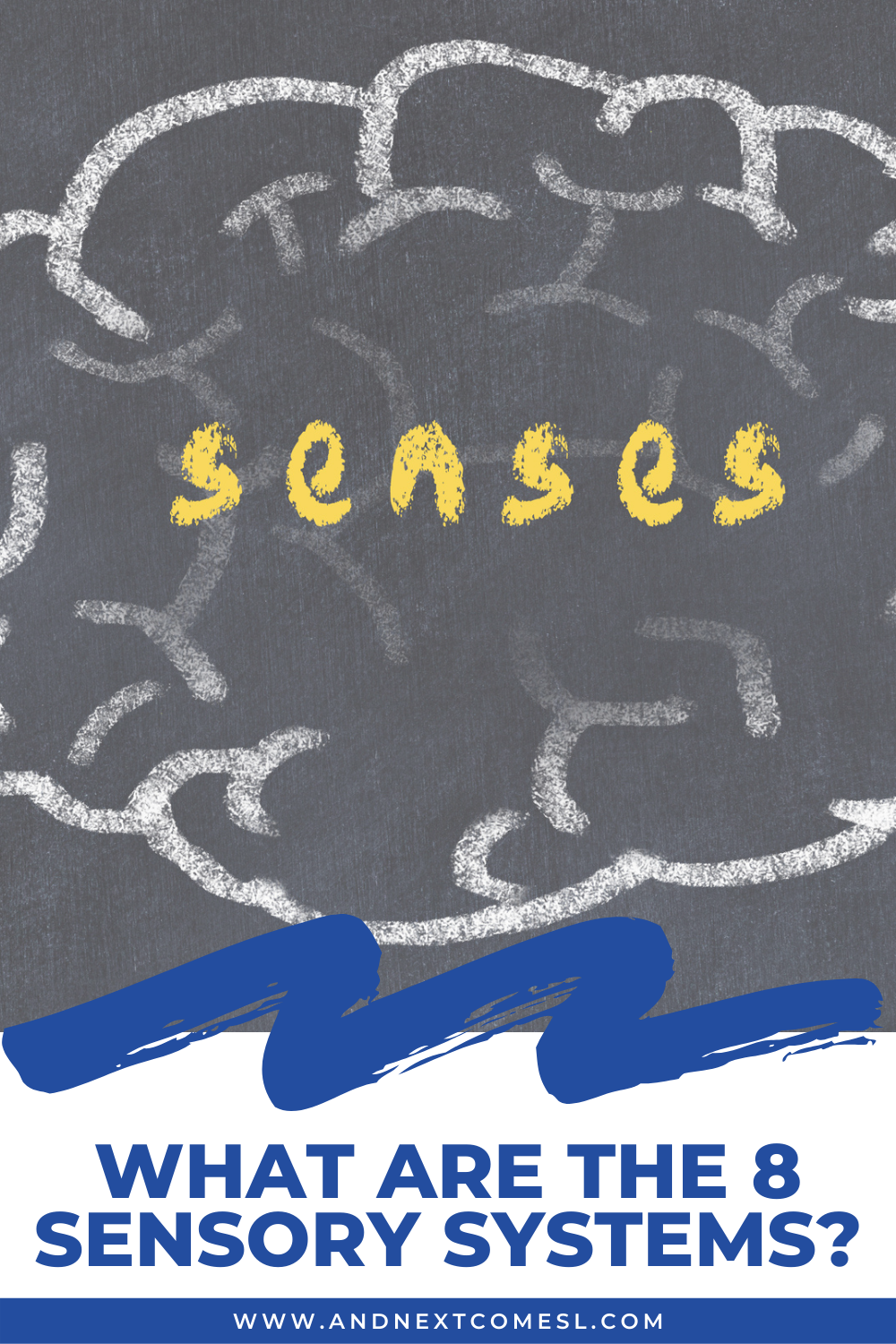Growing up, you probably learned that we have five senses, right? I mean how many times were sight, sound, touch, taste, and smell drilled into you throughout elementary school? Probably a lot. And your kids probably only learn about those five senses too. So you likely had no idea that there were other sensory systems beyond that. But there are!
So when your child (or maybe yourself) started experiencing sensory processing challenges, you started to wonder why your child liked spinning so much, yet never got dizzy. Or why they chewed on literally everything, even non-food objects. Or why they constantly bumped into things.
You quickly realized that their sensory processing difficulties couldn't be explained by just those five senses alone. You knew there had to be more to it than that.
Well, that's because we actually receive sensory input through eight different senses. Not five like you were taught.
And when you learn that we receive and process sensory stimuli using these 8 senses, things make so much more sense.
You'll suddenly have the words you need to explain your child's sensory differences. Regardless of what sensory sensitivity they might have. And that's powerful stuff. Especially when it comes to advocating for your child's needs. So let's dig in and learn more about the 8 senses then, shall we?
What are the 8 Sensory Systems?
Okay so you missed learning about three senses growing up. We already know that. But you likely also didn't learn big fancy names to go along with all of the senses. Not surprising though given how tricky some of these words are to spell, let alone pronounce. Especially as a kid. By the way, I'm looking at you, proprioception!
Anyway, here's a list of our eight sensory systems with their official names:
- Visual
- Auditory
- Gustatory
- Olfactory
- Tactile
- Vestibular
- Proprioception
- Interoception
The 8 Senses Explained & Defined
It's important to understand your child's unique sensory profile. Especially if they have a diagnosis such as autism or have a sensory disorder where sensory challenges are quite common. And part of understanding your child's sensory profile is learning about these sensory systems first.
After all, learning about these senses can give you a better idea of the sensory difficulties that your child might experience. It can also help you identify your child's sensory overload triggers, plan a sensory diet, and so much more.
So here are the 8 senses through which we process sensory information explained:
1. Visual - Known as our sense of sight, this sensory system is all about the information that we take in through our eyes (known as visual input). It's the things that we see.
2. Auditory - This sensory system is all about the sense of sound (aka the things that we hear). It refers to the information that we receive through the ears. But it also helps us filter out unwanted sensory stimuli in terms of the sounds that we do not need to attend to.
3. Gustatory - You probably know this one better as the sense of taste. Basically, this sense helps us make sense of taste and flavors and processes the information that we receive through the mouth. Sometimes this sense might be referred to as the oral system as well.
4. Olfactory - A fancy word for the sense of smell. This sense is all about interpreting the information that we receive through the nose.
5. Tactile - Also known as our sense of touch. It's responsible for processing the information we receive when we physically touch and feel things through our skin. It doesn't necessarily need to be things we touch with our hands though. It can be sensations that make contact with us anywhere on the body. Think of certain clothing items such as scratchy tags or lumpy socks that are bothersome. That falls under tactile as well.
6. Vestibular - Okay now we're getting into the less familiar senses. This one is all about our sense of balance and spatial awareness. And it's located in the inner ear. The vestibular system functions to detect changes in gravity like whether you are spinning or hanging upside down.
7. Proprioception - This sense processes information that is received from muscle and joint movements. It tells you where your different body parts are and what they are doing, which is why it's known as the body awareness sense. Think jumping, pushing, pulling, heavy work, deep pressure...they're all about proprioception!
8. Interoception - Known as the internal body sense, interoception is like your body's GPS. This internal GPS system is responsible for being aware of internal sensory input such as hunger, breathing, temperature, thirst, and having to go the bathroom. So basically it refers to the physiological and physical condition of the body. It tells you what your internal organs are feeling. Unfortunately, this sense is often forgotten about and is rarely discussed, but it's clearly an important one!
So that's our 8 senses explained. Hopefully it gives you a better understanding of how complex sensory processing is. It's clearly so much more than those five senses you learned about as a kid though, right?
Other Sensory Processing Resources You'll Love
The Best Sensory Bins for Engaging Tactile Sensory Play
How to Make a Budget-Friendly Sensory Space for Your Child
Books About Sensory Processing Disorders That You Should Probably Read






